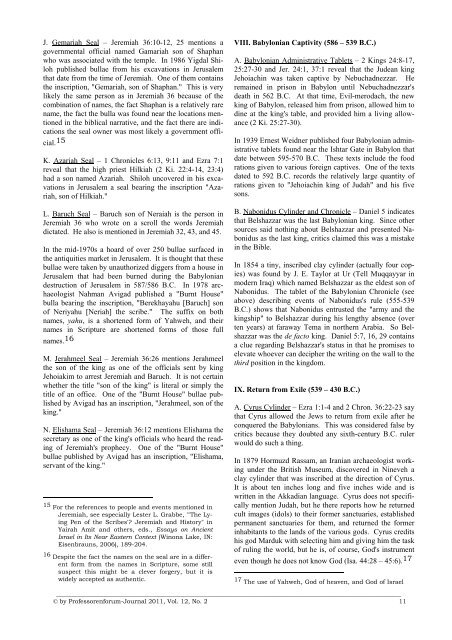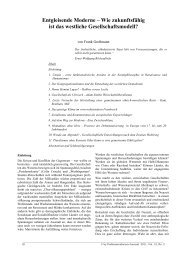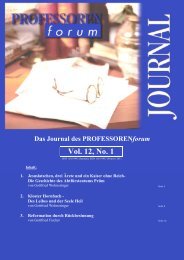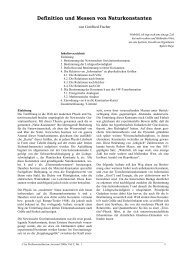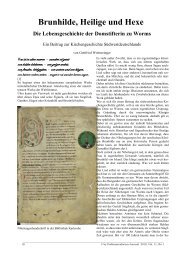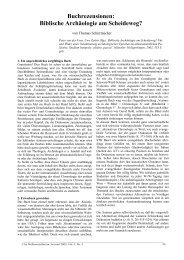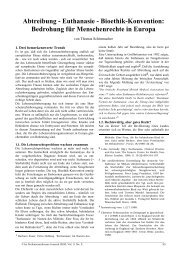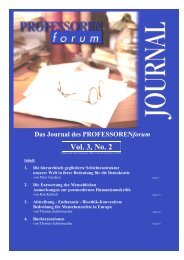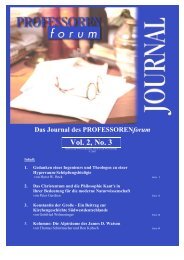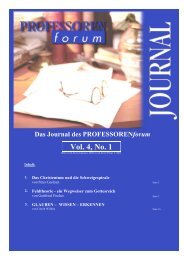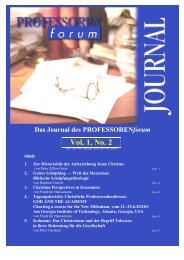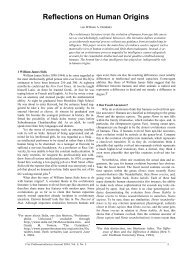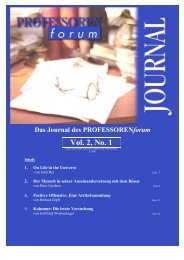Das Journal des PROFESSORENforum Vol. 12, No. 2
Das Journal des PROFESSORENforum Vol. 12, No. 2
Das Journal des PROFESSORENforum Vol. 12, No. 2
Sie wollen auch ein ePaper? Erhöhen Sie die Reichweite Ihrer Titel.
YUMPU macht aus Druck-PDFs automatisch weboptimierte ePaper, die Google liebt.
J. Gemariah Seal – Jeremiah 36:10-<strong>12</strong>, 25 mentions a<br />
governmental official named Gamariah son of Shaphan<br />
who was associated with the temple. In 1986 Yigdal Shiloh<br />
published bullae from his excavations in Jerusalem<br />
that date from the time of Jeremiah. One of them contains<br />
the inscription, "Gemariah, son of Shaphan." This is very<br />
likely the same person as in Jeremiah 36 because of the<br />
combination of names, the fact Shaphan is a relatively rare<br />
name, the fact the bulla was found near the locations mentioned<br />
in the biblical narrative, and the fact there are indications<br />
the seal owner was most likely a government official.<br />
15<br />
K. Azariah Seal – 1 Chronicles 6:13, 9:11 and Ezra 7:1<br />
reveal that the high priest Hilkiah (2 Ki. 22:4-14, 23:4)<br />
had a son named Azariah. Shiloh uncovered in his excavations<br />
in Jerusalem a seal bearing the inscription "Azariah,<br />
son of Hilkiah."<br />
L. Baruch Seal – Baruch son of Neraiah is the person in<br />
Jeremiah 36 who wrote on a scroll the words Jeremiah<br />
dictated. He also is mentioned in Jeremiah 32, 43, and 45.<br />
In the mid-1970s a hoard of over 250 bullae surfaced in<br />
the antiquities market in Jerusalem. It is thought that these<br />
bullae were taken by unauthorized diggers from a house in<br />
Jerusalem that had been burned during the Babylonian<br />
<strong>des</strong>truction of Jerusalem in 587/586 B.C. In 1978 archaeologist<br />
Nahman Avigad published a "Burnt House"<br />
bulla bearing the inscription, "Berekhayahu [Baruch] son<br />
of Neriyahu [Neriah] the scribe." The suffix on both<br />
names, yahu, is a shortened form of Yahweh, and their<br />
names in Scripture are shortened forms of those full<br />
names. 16<br />
M. Jerahmeel Seal – Jeremiah 36:26 mentions Jerahmeel<br />
the son of the king as one of the officials sent by king<br />
Jehoiakim to arrest Jeremiah and Baruch. It is not certain<br />
whether the title "son of the king" is literal or simply the<br />
title of an office. One of the "Burnt House" bullae published<br />
by Avigad has an inscription, "Jerahmeel, son of the<br />
king."<br />
N. Elishama Seal – Jeremiah 36:<strong>12</strong> mentions Elishama the<br />
secretary as one of the king's officials who heard the reading<br />
of Jeremiah's prophecy. One of the "Burnt House"<br />
bullae published by Avigad has an inscription, "Elishama,<br />
servant of the king."<br />
15 For the references to people and events mentioned in<br />
Jeremiah, see especially Lester L. Grabbe, "'The Lying<br />
Pen of the Scribes'? Jeremiah and History" in<br />
Yairah Amit and others, eds., Essays on Ancient<br />
Israel in Its Near Eastern Context (Winona Lake, IN:<br />
Eisenbrauns, 2006), 189-204.<br />
16 Despite the fact the names on the seal are in a different<br />
form from the names in Scripture, some still<br />
suspect this might be a clever forgery, but it is<br />
widely accepted as authentic.<br />
VIII. Babylonian Captivity (586 – 539 B.C.)<br />
A. Babylonian Administrative Tablets – 2 Kings 24:8-17,<br />
25:27-30 and Jer. 24:1, 37:1 reveal that the Judean king<br />
Jehoiachin was taken captive by Nebuchadnezzar. He<br />
remained in prison in Babylon until Nebuchadnezzar's<br />
death in 562 B.C. At that time, Evil-merodach, the new<br />
king of Babylon, released him from prison, allowed him to<br />
dine at the king's table, and provided him a living allowance<br />
(2 Ki. 25:27-30).<br />
In 1939 Ernest Weidner published four Babylonian administrative<br />
tablets found near the Ishtar Gate in Babylon that<br />
date between 595-570 B.C. These texts include the food<br />
rations given to various foreign captives. One of the texts<br />
dated to 592 B.C. records the relatively large quantity of<br />
rations given to "Jehoiachin king of Judah" and his five<br />
sons.<br />
B. Nabonidus Cylinder and Chronicle – Daniel 5 indicates<br />
that Belshazzar was the last Babylonian king. Since other<br />
sources said nothing about Belshazzar and presented Nabonidus<br />
as the last king, critics claimed this was a mistake<br />
in the Bible.<br />
In 1854 a tiny, inscribed clay cylinder (actually four copies)<br />
was found by J. E. Taylor at Ur (Tell Muqqayyar in<br />
modern Iraq) which named Belshazzar as the el<strong>des</strong>t son of<br />
Nabonidus. The tablet of the Babylonian Chronicle (see<br />
above) <strong>des</strong>cribing events of Nabonidus's rule (555-539<br />
B.C.) shows that Nabonidus entrusted the "army and the<br />
kingship" to Belshazzar during his lengthy absence (over<br />
ten years) at faraway Tema in northern Arabia. So Belshazzar<br />
was the de facto king. Daniel 5:7, 16, 29 contains<br />
a clue regarding Belshazzar's status in that he promises to<br />
elevate whoever can decipher the writing on the wall to the<br />
third position in the kingdom.<br />
IX. Return from Exile (539 – 430 B.C.)<br />
A. Cyrus Cylinder – Ezra 1:1-4 and 2 Chron. 36:22-23 say<br />
that Cyrus allowed the Jews to return from exile after he<br />
conquered the Babylonians. This was considered false by<br />
critics because they doubted any sixth-century B.C. ruler<br />
would do such a thing.<br />
In 1879 Hormuzd Rassam, an Iranian archaeologist working<br />
under the British Museum, discovered in Nineveh a<br />
clay cylinder that was inscribed at the direction of Cyrus.<br />
It is about ten inches long and five inches wide and is<br />
written in the Akkadian language. Cyrus does not specifically<br />
mention Judah, but he there reports how he returned<br />
cult images (idols) to their former sanctuaries, established<br />
permanent sanctuaries for them, and returned the former<br />
inhabitants to the lands of the various gods. Cyrus credits<br />
his god Marduk with selecting him and giving him the task<br />
of ruling the world, but he is, of course, God's instrument<br />
even though he does not know God (Isa. 44:28 – 45:6). 17<br />
17 The use of Yahweh, God of heaven, and God of Israel<br />
_________________________________________________________________________________________________________________<br />
© by Professorenforum-<strong>Journal</strong> 2011, <strong>Vol</strong>. <strong>12</strong>, <strong>No</strong>. 2 11


